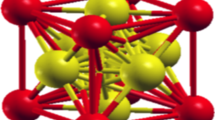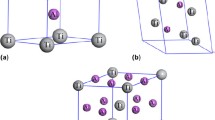Abstract
The electronic structures of pure Ti, Zr and Hf metals with hcp structure were determined by oneatom (OA) theory. According to the electronic structures of these metals, their potential curves, cohesive energies, lattice constants, elasticities and the temperature dependence of linear thermal expansion coefficients were calculated. The electronic structures and characteristic properties of these metals with bcc and fcc structures and liquids were also studied. The results show that the electronic structures of Ti, Zr and Hf metals are respectively [Ar] (3dn)0.481 0 (3dc)2.085 7 (4sc)1.000 0 (4sf)0.433 3, [Kr] (4dn)0.396 8 (4dc)2.142 8 (5sc)1.262 0 (5sf)0.198 4, [Xe](5dn)0.368 0(5dc)2.041 4(6sc)1.406 6(6sf)0.184 0. It is explained why the pure Ti, Zr and Hf metals with hcp and bcc structures can exist naturally, while those with fcc structure can not.
Similar content being viewed by others
References
Willaime F, Massobro C. Temperature-induced hcp-bcc phase transformation in zirconium—a lattice and molecular-dynamics study based on an N-body potential[J]. Phys Rev Lett, 1989, 63: 2244–2247.
Petry W, Heiming A. Phonon dispersion of the bcc phase of group-IV metals[J]. Phys Rev, 1991, B43: 10933–10963.
Dinsade A T. SGTE data for pure metals[J]. CALPHAD, 1991, 15: 412–517.
Blaha P, Schwarz K, Dederichs P H. Electronic structure of hcp metals[J]. Phys Rev, 1988, B38: 9368–9374.
Sigalas M, Papacostantpoulos D A, Bacalis N C. Total energy and band structure of the 3d, 4d and 5d metals[J]. Phys Rev, 1992, B45: 5777–5783.
Michael J, Mehl, Papacostantpoulos D A. Applications of a tight-binding total-energy method for transition and noble metal: elastic constants, vacancies and surfaces of monatomic metals[J]. Phys Rev, 1996, B54: 4519–4530.
XIE Y Q, LU M S, ZHANG X D. Electronic structure and properties of pure nicke[J]. Science in China (series A), 1993, 23(4): 495–503.
XIE Y Q. The electronic structure and properties of pure iron[J]. Acta Metall Mater, 1994, 42: 3705.
Pauling L. The nature of the chemical bond[M]. Itheca: Cornell University Press, 1960.
King H W. Crystal structures of the elements[J]. Bulletin of Alloy Phase Diagram, 1981, 2: 401–402.
Wight E Gray. American institute of physics handbook(3rd edition)[M]. New York: Mccraw-Hil Book Company, Inc, 1972.
Author information
Authors and Affiliations
Additional information
Foundation item: The Natural Science Foundation of Hunan Province (No. 99JZY1005)
Biography of the first author: XIE You-qing, professor, born in 1937, majoring in materials science.
Rights and permissions
About this article
Cite this article
Xie, Yq., Peng, K. & Yang, Xx. Electronic structures and properties of Ti, Zr and Hf metals. J Cent. South Univ. Technol. 8, 83–88 (2001). https://doi.org/10.1007/s11771-001-0031-6
Received:
Published:
Issue Date:
DOI: https://doi.org/10.1007/s11771-001-0031-6




